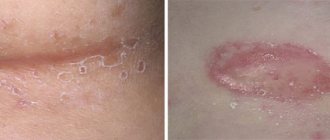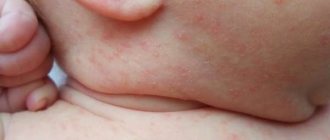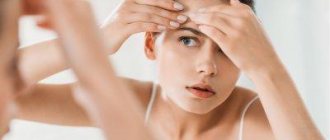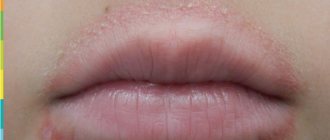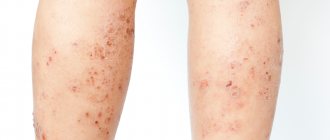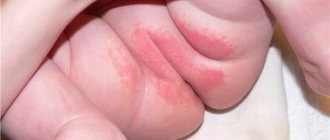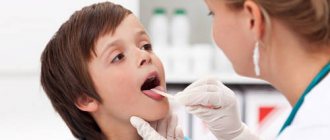A newborn baby undergoes a number of changes in the body at all levels. They regulate the functions of organs, like settings. Hormonal rash in newborns (neonatal cephalic pustulosis) is one of the stages of adaptation to new environmental conditions. You need to be prepared for this, and not panic because of the appearance of a rash. The temporary phenomenon frightens young parents with its sudden development and unknown root cause. At an appointment with a doctor, you can determine the nature of the rash, eliminate the bacterial or infectious nature of the occurrence, and receive recommendations for caring for your baby. Hormonal rash on the face of a newborn is a common occurrence that does not carry hidden health threats.
Hormonal rash in infants and causes
In the first weeks after birth, 30-35% of babies develop symptoms of a characteristic rash. Neonatal cephalic pustulosis is also affectionately called “newborn bloom.” Young parents may hear other options: acne or baby acne, milia, three-week rash. These are all names of the same diagnosis. Hormonal rash predominantly occurs at the end of the first week of life, but the typical time frame can be extended to 3 months. Main causes:
- increased levels of estrogen in the blood;
- activation of the sebaceous glands;
- blockage of follicles;
- proliferation of yeast-like fungi.
Mechanism of development in the body
Hormonal rash in a child directly depends on the mother’s hormones. Excessive amounts of estrogens accumulated in the body after birth must be eliminated from the body, and hormonal levels should be normalized. Under the influence of the same factor, including adrenal androgens, the sebaceous glands are activated. They actively produce excess subcutaneous fat. The skin and pores do not have time to cope with the incoming amount. This leads to clogged pores and follicles. And the proliferation of yeast-like fungi contributes to the development of the inflammatory process. In 52% of cases, the Malassezia species was detected in smears. All processes are closely interconnected.
Causes of rashes in a newborn
During pregnancy, the baby receives large quantities of hormones from the mother. After birth, the child’s body tries to get rid of them. The child experiences a so-called hormonal crisis. Excess maternal hormones cause the sebaceous glands to work actively. Since they are not yet able to function normally, blockage occurs and pimples appear.
Symptoms and signs
The first signs can be noticed from the first days of the baby. The peak of manifestation occurs on days 5-7. Hormonal rash looks different in infants. These are mostly red spots with a white head in the center. Pimples may have a yellowish or whitish tint, barely rising above the skin. The rashes are localized mainly on the forehead, nose, chin, ears, and chest area, but in more complex cases they can be on the back and other parts of the body. Closed comedones are few in number, appearing in the form of separate formations. They may merge into small spots. The important point is the absence of itching and pain. Hormonal rash in newborns is accompanied by a number of characteristic signs:
- swelling of the mammary glands in boys and girls;
- swelling of the scrotum area in boys;
- vulvovaginitis or spotting in girls.
When to see a doctor
Hormonal rash is not classified as a disease. It is inherently safe. It may go away in a few days, but not in all cases. It happens that it takes 1.5-2 or even 6 months to completely cleanse the skin of papules. Depending on the state of health, the rash may migrate and periodically worsen. How quickly and when the hormonal rash in infants goes away depends on the efficiency of self-removal of estrogens from the body. Parents should be alerted to the different external signs of a three-week rash, as well as the protracted healing period. Up to a maximum of 1 year, the child’s hormonal levels should return to normal, and all manifestations should disappear. It is necessary to contact a pediatrician or dermatologist at JSC “Medicine” (clinic of Academician Roitberg) in the Central Administrative District if the recovery period is exceeded. A rash due to hormonal imbalance in children over one year old is already equated to pathological conditions.
How to distinguish from allergies
Children have contact and food allergies. They can be identified by location and time of manifestation. Contact allergies occur on the skin only in those places where there was contact with the irritant. An example would be a diaper. In places of contact with its materials along the legs, in folds, on the buttocks, and lower back, rashes appear without clear boundaries. Red spots can merge into large areas of the lesion. Allergies are also characterized by a feeling of itching and, accordingly, anxiety in the child. This may be accompanied by a runny nose, conjunctivitis, moodiness, etc. Food allergies occur within 24 hours after consuming an allergenic product. It appears in the form of rough spots on the cheeks, reminiscent of an unhealthy blush. Hormonal rash in a child does not have such manifestations.
How to distinguish from infection
Measles, roseola, chickenpox, rubella, scarlet fever are diseases that are best dealt with in childhood. Each of them is characterized by a certain location of the rash, accompanied by specific symptoms. Hormonal acne has nothing in common with these diseases. It occurs without changes in body temperature, changes in appetite or sleep patterns. The infection covers a large area of the skin and can be localized in different places at the same time. Infectious rashes are characterized by the following:
- clear boundaries of lesions;
- the rash does not have the appearance of closed comedones (small wen);
- There is an increase in temperature and poor health.
Clinical researches
Clinical studies have proven the effectiveness, safety and tolerability of the products. The products are suitable for daily care of children's skin with mild to moderate forms of atopic dermatitis and during remission, accompanied by a decrease in the quality of life of patients.
The properties of the products are confirmed by clinical studies, during which it was found that La-Cri cream for sensitive skin:
- reduces itching and irritation;
- relieves skin redness;
- moisturizes and gently cares for the skin.
Based on the results of clinical studies, the product packaging contains information that the creams are recommended by the St. Petersburg branch of the Union of Pediatricians of Russia.
Sources:
- Kamasheva G.R., Khakimova R.F. Valiullina S.A., Methods for assessing the severity of atopic dermatitis in young children, Dermatology journal, 2010
- Kovyazina N.A., Fedosimova N.A., Illek Ya. Yu. Diagnosis of atopic dermatitis in young children, Vyatka Medical Bulletin, 2007
- Smirnova G.I. Managing the course of the disease: atopic dermatitis in children, Russian pediatric journal, 2014
Photos of allergies in children
Photo album on the disease
Hormonal rash in babies: treatment
By medical standards, hormonal rash in newborns is not considered a disease. This means that this temporary phenomenon does not require special treatment. It is necessary to show the child to a pediatrician or dermatologist to confirm the diagnosis, but you should not self-medicate. At JSC “Medicine” (academician Roitberg’s clinic), doctors will conduct an examination and, if necessary, do laboratory tests (scraping, smear). During the period of appearance and exacerbation of rashes, it is important to follow hygiene rules. Under no circumstances should you remove closed comedones to prevent infection. Otherwise, hormonal acne may progress to the stage of suppuration. This is already considered a serious case, requiring special care. A rash due to hormonal imbalance after birth appears and will go away on its own. The following procedures are not recommended:
- dry papules with alcohol solutions;
- smear with iodine or brilliant green;
- wipe with herbal infusions;
- apply baby cream and ointments;
- use adsorbents;
- give antibiotics;
- use powder with talcum powder, etc.
Useful tips for parents
A hormonal rash on a newborn’s face or body, if properly cared for, is not a cause for concern. It is recommended to follow simple rules. They consist of daily water procedures, the need to take air baths, and it is also necessary to protect the child from overheating. Sweaty skin will complicate the healing process and can cause inflammation in the affected areas. Hormonal rash is considered a physiological phenomenon in babies, but proper care will help speed up the cleansing of the skin. To avoid causing additional irritation, use hypoallergenic powders for washing. Another important point is that a child can scratch himself. Trim your nails carefully or use special anti-scratch mittens.
Should neonatal rash be treated?
There is no need to treat a three-week rash in an infant. There are times when a baby damages pimples and introduces an infection into them. In this case, ointments are used that have an antiseptic effect. To prevent your baby from scratching the rash, you need to carefully trim your nails and wear special anti-scratch mittens.
READ ALSO: Diet for acne
Treatment is prescribed only if the rash progresses very quickly or lasts more than 3 months. Sometimes there is a severe blockage of the duct. In this case, the doctor will prescribe special ointments (Bepanten, Ketoconazole).
It is necessary to monitor the hygiene of the baby’s skin, bathe him regularly, give him baths with medicinal herbs (decoction of chamomile, string, calendula). You can use a weak solution of manganese or Chlorophyllipt for bathing. For washing, use regular baby soap.
For skin problems, herbal baths are deservedly popular.
The baby needs to regularly take sun and air baths and go for walks more often. A nursing mother should follow a hypoallergenic diet. After the hormonal levels normalize, the rashes will disappear, and no trace will remain on the skin.
How to make an appointment with a doctor
Hormonal rash does not require treatment, but it will not be superfluous to monitor the baby’s condition. In case of atypical development of the overall picture, therapy may be required. JSC "Medicine" (clinic of academician Roitberg) is located in the center of Moscow: 2nd Tverskoy-Yamskaya lane, building 10. Nearby are the metro stations "Mayakovskaya", "Novoslobodskaya", "Belorusskaya", "Tverskaya", "Chekhovskaya". You can make an appointment with a pediatrician by phone. A feedback option is available on the clinic’s website. In a special form you need to enter your information (name and phone number), after which the administrator will call you back to clarify information about the proposed appointment. The clinic welcomes doctors from various subspecialties. These are not only pediatricians, but also a dermatologist, cardiologist, psychologist, immunologist, allergist, neurologist, speech therapist and other doctors. The clinic pays attention to young patients, takes care of their emotional comfort, and uses advanced diagnostic technologies and innovative treatment methods.
Food allergies
Can you be allergic to breast milk? Alas, even a newborn baby is not immune from this. If we omit hereditary factors, an allergy to breast milk is most often associated with the diet of a nursing mother. Therefore, the basis of treatment in this case is a thorough analysis and adjustment of the mother’s menu. First of all, potential allergens are excluded: cow's milk (the baby's immune system views cow protein as foreign), chicken eggs, fish and seafood, mushrooms, nuts, honey and brightly colored vegetables and fruits. In the first 2–3 months of life, the baby’s digestive tract is just forming and there are no protective enzymes, so the young mother must be extremely attentive to what she eats. Even better, at the first sign of an allergy, start writing down your daily menu. This will greatly facilitate your further work with an allergist when making a diagnosis and prescribing treatment.
A doctor's help is also necessary if the baby is on artificial nutrition and the mother suspects that an allergic reaction is caused by components of the infant formula. In this case, after the examination, the allergist will prescribe a hypoallergenic diet for the child.
What are the symptoms of allergies in an infant? The entry of a foreign antigen into the baby’s body can be expressed in different ways:
- various rashes;
- peeling skin on the cheeks;
- diaper rash;
- constant nasal congestion;
- excessive regurgitation;
- vomiting and loose stools;
- difficulty breathing;
- Quincke's edema (in extremely rare cases).
Agree, some of these symptoms are extremely similar to prickly heat and diathesis. How to correctly identify them? Miliaria in the form of small blisters in the folds of the skin and on the neck usually does not cause discomfort to the baby and goes away without a trace after 2-3 days (provided there is no overheating in the future). Diathesis is nothing more than the first bell, forcing the mother to seriously think about the child’s tendency to allergies. It is directly related to the baby’s adaptation to the external environment and the formation of its gastrointestinal tract. The most common causes of diathesis are dry air, chlorinated water, washing powders and, of course, the mother’s improper diet. Diathesis is manifested by loose stools, a bright rash, red cheeks, but with proper therapy it disappears without a trace in the first years of life.
Non-food allergies
So, we are very close to the appearance of allergic reactions in infants that are not related to food. In the vast majority of cases, their cause lies in heredity and constant contact with the allergen. Most often, the body's reaction can be caused by:
- dust and dust mites;
- animal hair;
- plant pollen;
- household chemicals;
- children's cosmetics.
To find out what exactly caused the allergic reaction, the doctor performs skin tests. To do this, apply one or another suspected allergen to the baby’s skin and monitor the reaction. If after a certain time the skin has not changed, they move on to the next possible “culprit”... and so on until the allergen is identified. After all this, the mother’s task is to find a way to isolate the baby from contact with the allergen and select the optimal medicinal support.
I would like to make a separate point about the baby’s allergic reaction to diapers. In this case, the rash consists of small dots with redness, itching, and swelling, which invariably raises a lot of questions for parents. The first step is to exclude diaper dermatitis, which manifests itself with rare diaper changes, and the factor of mechanical irritation (inconvenient Velcro and elastic bands). In other cases, allergies may occur due to:
- using cheap diapers made from low-quality materials or counterfeits;
- frequent changes of brands of diapers;
- additional components in the composition of diapers (chamomile, aloe).
Get rid of allergies, pick up a healing ointment and switch to Huggies - diapers with natural 100% cotton and hypoallergenic porous materials that allow your baby's skin to breathe.
